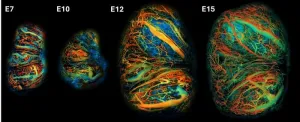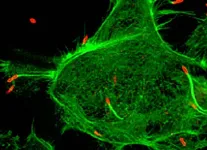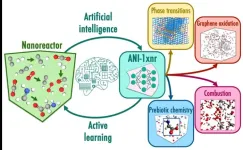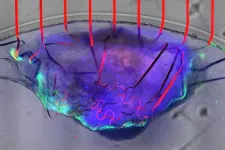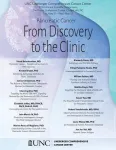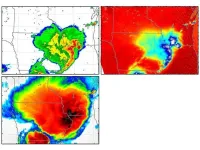(Press-News.org) DURHAM, N.C. -- Physicians and biomedical engineers at Duke University have developed a method to visualize the growth of a placenta throughout a mouse’s pregnancy. By coupling an implantable window with ultrafast imaging tools, the approach provides the first opportunity to track placental development to better understand how the organ functions during pregnancy.
This new perspective gives researchers a precise way to examine how lifestyle factors like alcohol consumption and health complications like inflammation can affect the placenta and potentially lead to adverse pregnancy outcomes.
The research appears March 20 as the cover article in Science Advances.
The placenta is a highly vascular organ that forms between the mother and fetus, providing oxygen and nutrients while removing waste. Even though problems in its development can lead to a cadre of health issues for both parties, little is known about how it grows and functions and there are few effective treatments for when things go wrong.
Much of this is because the organ has proved difficult to study. Researchers rely on mouse models, because mouse and human placentas share similar anatomical, cellular and molecular features. But even this is tricky, as the organ is deep in the abdominal cavity and is constantly moving, making it a challenge to image with traditional tools.
A new approach developed by Junjie Yao, associate professor of biomedical engineering at Duke, and Dr. Liping Feng, associate professor of obstetrics and gynecology at the Duke University School of Medicine, bypasses these problems by creating a safe, implantable window that provides direct access to the placenta in pregnant mice. By pairing this tool with the imaging technique ultrafast functional photoacoustic microscopy (UFF-PAM), the team can capture highly detailed images of the blood flow and oxygen metabolism of the complex organ.
“UFF-PAM can achieve high imaging speed, so the images aren’t disrupted by breathing or the motions of the embryo or placenta,” said Yao. “By using it with the implantable window, we can see how the placenta grows, how it recruits new blood vessels, how it feeds the fetus, and other drastic changes in both healthy and diseased states over the 20-day gestational period.”
Traditional photoacoustic microscopy (PAM) uses the properties of light and sound to capture detailed images of organs, tissues and cells throughout the body. The technique uses a laser to send light into a targeted tissue or cell. When the laser hits the cell, it heats up and expands instantaneously, creating an ultrasonic wave that travels back to a sensor. The UFF-PAM system relies on a combination of hardware advancements and machine learning algorithms to upgrade this technique, making it faster and more sensitive.
The team first used their technique to study placental blood supplies during a healthy pregnancy. From day seven to day 19 of fetal development, the team tracked blood vessel size, vessel density and oxygen levels.
Oxygen levels dropped slightly from day seven to day 10, while both blood vessel diameter and density increased by more than 200%.
“We normally see that low-oxygen environment in tumors, not in organs,” said Yao. “But the highly vascular placenta grows quickly, just like the tumors. The low-oxygen environment triggers the placenta to grow a lot of vessels to facilitate the exchange of nutrients, oxygen and waste products between the mother and the fast-developing fetus. As the vessels develop, the oxygen level rises.”
Next, the team explored how different lifestyle factors and health complications affected the development of the placenta and health of the fetus. Starting with alcohol consumption, they injected ethanol into the abdominal cavity and used UFF-PAM to observe the changes in the organ’s blood dynamics. While the alcohol caused a small decrease in the total blood vessel density, there was a significant initial increase in oxygen levels in the placenta.
“Alcohol consumption during pregnancy can affect the developing placenta and fetus, but nobody really knows why or how,” said Feng. “Our study provides evidence that alcohol can affect placental development by altering its blood flow and oxygen metabolism.”
The team also tested a model that mimicked inflammation caused by an immune response or infection. During pregnancy, the placenta helps prevent the mother’s immune system from attacking and rejecting the fetus. However, this immune barrier can be disrupted, leading to pregnancy complications such as pregnancy loss, preterm birth, smaller babies, and preeclampsia. However, it is not clear how inflammation or infection affects the placental blood flow. In their model, the team observed that an inflammatory reaction resulted in significantly fewer and smaller blood vessels in the mouse’s placenta. These placental vasculature changes were accompanied by higher oxygen levels compared to the healthy control group, so the placenta wasn’t triggered to make more blood vessels by being hypoxic.
“Using this novel imaging tool in these mouse models, we can provide detailed insights into the placental structure, vascularization, and function in real-time,” Feng said.
Now that the team has a proof of concept, they plan to study more specific conditions and how they affect the placenta.
“These tools not only help us to understand how pregnancy complications happen but also provide a pre-clinical tool for drug screening,” Feng said. They also want to test how common drugs, like aspirin, affect pregnancy.
“There is so much we don’t know about pregnancy, especially from a fundamental research perspective,” Yao said. “We’re hopeful that this tool can help us tackle those long-standing problems and mysteries so we can make pregnancy safer.”
END
Novel imaging platform allows researchers to study placental development in pregnant mice
New approach tracks blood flow and oxygen levels in the developing placenta of mice throughout pregnancy
2024-03-21
ELSE PRESS RELEASES FROM THIS DATE:
AMS Science Preview: “Outdoor days,” lightning, air pollution
2024-03-21
The American Meteorological Society continuously publishes research on climate, weather, and water in its 12 journals. Many of these articles are available for early online access–they are peer-reviewed, but not yet in their final published form.
Below is a selection of articles published early online recently. To view full article text, members of the media can contact kpflaumer@ametsoc.org for press login credentials.
Observed Changes in Extreme Precipitation Associated with United States Tropical Cyclones
Journal of Climate
Rainfall ...
Illinois study: Systematic review of agricultural injuries can help inform safety measures
2024-03-21
URBANA, Ill. – Agricultural occupations are hazardous with one of the highest rates of workplace injuries and fatalities in the U.S. The manual and often strenuous nature of the work, combined with the use of machinery and exposure to environmental hazards create a challenging work environment. Understanding the nature and causes of injuries can help improve safety guidelines and policy measures. However, obtaining a comprehensive overview of injuries is hindered by the absence of a central reporting system. Two ...
New vaccine against a highly fatal tropical disease – and potential bioterror weapon – demonstrates efficacy in animal studies
2024-03-21
In a mouse study, UCLA researchers tested a vaccine against the bacterium that causes melioidosis and found it was highly protective against the disease, which is endemic in many tropical areas, causing approximately 165,000 cases with 89,000 fatalities around the world each year.
The bacterium, called Burkholderia pseudomallei, is spread through contact with contaminated soil and water through inhalation, ingestion or broken skin. It is so dangerous that it is categorized as a Tier 1 Select Agent of bioterrorism, and it can cause ...
Artificial intelligence helps explore chemistry frontiers
2024-03-21
The ability to simulate the behavior of systems at the atomic level represents a powerful tool for everything from drug design to materials discovery. A team led by Los Alamos National Laboratory researchers has developed machine learning interatomic potentials that predict molecular energies and forces acting on atoms, enabling simulations that save time and expense compared with existing computational methods.
“Machine learning potentials increasingly offer an effective alternative to computationally ...
UMass Amherst engineers create bioelectronic mesh capable of growing with cardiac tissues for comprehensive heart monitoring
2024-03-21
AMHERST, Mass. – A team of engineers led by the University of Massachusetts Amherst and including colleagues from the Massachusetts Institute of Technology (MIT) recently announced in the journal Nature Communications that they had successfully built a tissue-like bioelectronic mesh system integrated with an array of atom-thin graphene sensors that can simultaneously measure both the electrical signal and the physical movement of cells in lab-grown human cardiac tissue. In a research first, this tissue-like mesh can grow along with the cardiac cells, ...
Researchers take major step toward developing next-generation solar cells
2024-03-21
The solar energy world is ready for a revolution. Scientists are racing to develop a new type of solar cell using materials that can convert electricity more efficiently than today’s panels.
In a new paper published February 26 in the journal Nature Energy, a University of Colorado Boulder researcher and his international collaborators unveiled an innovative method to manufacture the new solar cells, known as perovskite cells, an achievement critical for the commercialization of what ...
CUNY ISPH to launch next phase of community-based cohort study to track short- and long-term effects of multiple respiratory viruses
2024-03-21
The City University of New York (CUNY) Institute for Implementation Science in Population Health (ISPH) and the CUNY Graduate School of Public Health and Health Policy (CUNY SPH), in collaboration with Pfizer, are initiating a critical two-year prospective epidemiologic study in the spring of 2024 to track acute respiratory infections across the United States.
Project PROTECTS (Prospective Respiratory Outcomes from Tracking and Evaluating Community-based TeSting) builds on the CHASING COVID Cohort Study, which has monitored SARS-CoV-2 infection rates and ...
47th Annual UNC Lineberger Scientific Symposium: “Pancreatic Cancer: From Discovery to the Clinic”
2024-03-21
UNC Lineberger Comprehensive Cancer Center is hosting its 47th annual scientific symposium, “Pancreatic Cancer: From Discovery to the Clinic,” on May 21-22 at the Friday Center for Continuing Education in Chapel Hill, North Carolina.
The symposium is free and will feature 15 talks on the latest in pancreatic cancer basic, translational and clinical research by faculty at the University of North Carolina, Dana-Farber Cancer Institute, Johns Hopkins Sidney Kimmel Cancer Center, Memorial Sloan Kettering Cancer Center, University of Michigan ...
A new path to drug diversity
2024-03-21
Many important medicines, such as antibiotics and anticancer drugs, are derived from natural products from Bacteria. The enzyme complexes that produce these active ingredients have a modular design that makes them ideal tools for synthetic biology. By exploring protein evolution, a team led by Helge Bode from the Max Planck Institute for Terrestrial Microbiology in Marburg, Germany, has found new "fusion sites" that enable faster and more targeted drug development.
Industry often follows the assembly line principle: components are systematically assembled into complex products, with different production lines yielding different products. However, not humans are the ...
Satellite data assimilation improves forecasts of severe weather
2024-03-21
UNIVERSITY PARK, Pa. — In 2020, a line of severe thunderstorms unleashed powerful winds that caused billions in damages across the Midwest United States. A technique developed by Penn State scientists that incorporates satellite data could improve forecasts — including where the most powerful winds will occur — for similar severe weather events.
The researchers reported in the journal Geophysical Research Letters that adding microwave data collected by low-Earth-orbiting satellites to existing computer weather forecast models produced more accurate forecasts of surface gusts in a case study of the 2020 Midwest ...
LAST 30 PRESS RELEASES:
Why nail-biting, procrastination and other self-sabotaging behaviors are rooted in survival instincts
Regional variations in mechanical properties of porcine leptomeninges
Artificial empathy in therapy and healthcare: advancements in interpersonal interaction technologies
Why some brains switch gears more efficiently than others
UVA’s Jundong Li wins ICDM’S 2025 Tao Li Award for data mining, machine learning
UVA’s low-power, high-performance computer power player Mircea Stan earns National Academy of Inventors fellowship
Not playing by the rules: USU researcher explores filamentous algae dynamics in rivers
Do our body clocks influence our risk of dementia?
Anthropologists offer new evidence of bipedalism in long-debated fossil discovery
Safer receipt paper from wood
Dosage-sensitive genes suggest no whole-genome duplications in ancestral angiosperm
First ancient human herpesvirus genomes document their deep history with humans
Why Some Bacteria Survive Antibiotics and How to Stop Them - New study reveals that bacteria can survive antibiotic treatment through two fundamentally different “shutdown modes”
UCLA study links scar healing to dangerous placenta condition
CHANGE-seq-BE finds off-target changes in the genome from base editors
The Journal of Nuclear Medicine Ahead-of-Print Tip Sheet: January 2, 2026
Delayed or absent first dose of measles, mumps, and rubella vaccination
Trends in US preterm birth rates by household income and race and ethnicity
Study identifies potential biomarker linked to progression and brain inflammation in multiple sclerosis
Many mothers in Norway do not show up for postnatal check-ups
Researchers want to find out why quick clay is so unstable
Superradiant spins show teamwork at the quantum scale
Cleveland Clinic Research links tumor bacteria to immunotherapy resistance in head and neck cancer
First Editorial of 2026: Resisting AI slop
Joint ground- and space-based observations reveal Saturn-mass rogue planet
Inheritable genetic variant offers protection against blood cancer risk and progression
Pigs settled Pacific islands alongside early human voyagers
A Coral reef’s daily pulse reshapes microbes in surrounding waters
EAST Tokamak experiments exceed plasma density limit, offering new approach to fusion ignition
Groundbreaking discovery reveals Africa’s oldest cremation pyre and complex ritual practices
[Press-News.org] Novel imaging platform allows researchers to study placental development in pregnant miceNew approach tracks blood flow and oxygen levels in the developing placenta of mice throughout pregnancy
